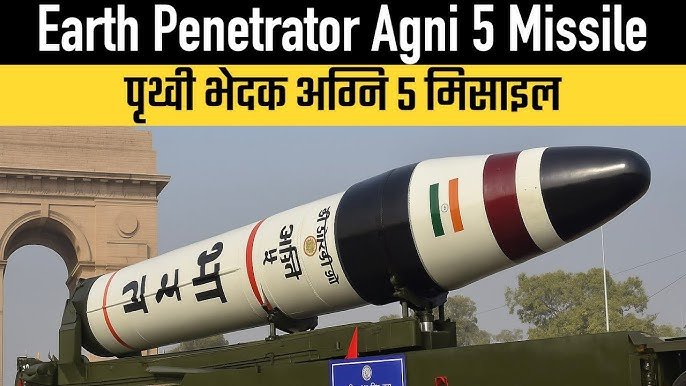India has once again proven its growing technological and military competence by successfully test-firing its most advanced ballistic missile, the Agni-5. With a range of up to 5,000 km, this nuclear-capable Intermediate Range Ballistic Missile (IRBM) can strike deep into Asia, including northern China, and even parts of Europe.
The test, carried out at the Integrated Test Range in Chandipur, Odisha, under the supervision of the Strategic Forces Command (SFC), validated all operational and technical parameters. For India, this test wasn’t just another routine missile trial—it was a powerful statement of strategic deterrence, resilience, and readiness in a volatile regional environment.
What Makes the Agni-5 Test So Significant?
This launch comes roughly three-and-a-half months after Operation Sindoor, which arose from escalating tensions with Pakistan, and a year after the previous Agni-5 trial in March.
The test is significant because:
-
It reaffirms India’s second-strike capability—the backbone of its nuclear doctrine.
-
It demonstrates operational readiness, ensuring that the Agni-5 isn’t just a technological success but a battlefield-ready system.
-
It signals to adversaries that India’s deterrence capability isn’t stagnant but constantly evolving.
In short, Agni-5 isn’t just about range—it’s about geopolitical messaging.
Agni-5: Technical Specifications
The Agni-5 represents the pinnacle of indigenous missile technology developed under India’s Defence Research and Development Organisation (DRDO). Let’s break it down:
-
Type: Intermediate-Range Ballistic Missile (IRBM)
-
Range: 5,000 km (covers almost all of Asia and parts of Europe)
-
Payload: Nuclear-capable, can carry a warhead of 1,500 kg class
-
Propulsion: Three-stage solid-fuel rocket
-
Launch Platform: Road-mobile launchers & canisters for fast deployment
-
Guidance System: Advanced navigation with Ring Laser Gyroscope (RLG) technology for high accuracy
-
Readiness: Can be quickly transported and launched, boosting survivability in conflict scenarios
In essence, it’s a precision strike weapon designed to deter aggression without even being used.
India’s Agni Series: A Quick Recap
The Agni missile series forms the backbone of India’s strategic deterrence. Each version has progressively increased in range and destructive capability:
-
Agni-I: Short-range (700–900 km), capable of carrying 1,000 kg payloads.
-
Agni-II: Medium-range (2,000 km), already inducted.
-
Agni-III: Longer-range (3,000–3,500 km).
-
Agni-IV: 3,500–4,000 km, adding more accuracy.
-
Agni-V: 5,000 km, covering almost all strategic rivals.
Together, they allow India to deter threats from any direction, both regionally and continentally.
Other Missiles Recently Tested
India’s missile program doesn’t stop at Agni-5. A series of recent tests show India’s multi-layered deterrence strategy:
-
Prithvi-II: Short-range ballistic missile (350 km), nuclear-capable, payload of 500 kg.
-
Agni-I: Tested again to validate combat-readiness (range up to 900 km).
-
Pralay: A tactical surface-to-surface missile with a 500–1,000 kg conventional warhead, range of 150–500 km, aimed at deterring battlefield threats.
Collectively, these systems ensure that India has options at every level of conflict escalation.
Why Solid-Fuel Propulsion Matters
Agni-5 uses a three-stage solid-fuel propulsion system. But why does this matter?
Unlike liquid-fueled missiles, solid-fuel systems are:
-
Easier to maintain
-
Faster to launch (reduced response times)
-
Highly mobile due to lighter design
-
More reliable in extreme weather or battlefield conditions
This makes the Agni-5 a survivable and responsive deterrent, qualities that are essential in a nuclear standoff.
Strategic Implications: Who’s Watching Closely?
Every missile test in South Asia sparks international interest—and concern. The Agni-5 is no exception.
-
China: With its northern provinces within range, China sees this as India flexing its deterrent capability. Beijing closely monitors Agni-5 developments.
-
Pakistan: While Pakistan already faces shorter-range Agni missiles, Agni-5th highlights India’s expanded deterrence posture, showing Islamabad that India remains technologically ahead.
-
Global Powers: The US and Russia, though not direct adversaries, keep a close eye since Agni-5 strengthens India’s status as a regional security actor.
The message is loud and clear—India is no longer just a regional power; it’s edging closer toward being a global military influencer.
Agni-5 and India’s Nuclear Doctrine
India follows a “No First Use” (NFU) nuclear policy. That means India promises not to use nuclear weapons unless attacked with them first.
So, why does India need Agni-5?
-
It reinforces India’s second-strike capability, ensuring any nuclear attack will be met with massive retaliation.
-
It adds credibility to India’s deterrent posture.
-
It deters both regional rivals and potential extra-regional threats.
Essentially, Agni-5 embodies India’s philosophy: We don’t start conflicts, but we’ll damn well finish them.
Missile Defence and Precision Technology
The Agni-5 isn’t just about range—it’s about pinpoint accuracy. The advanced Micro Inertial Navigation System (MINGS) coupled with satellite guidance allows it to land within a few meters of its target—making it a truly modern strategic asset.
Combine this with evolving Indian missile defense systems, and what you get is a layered shield and sword approach—India can defend itself while striking back if needed.
How Agni-5 Strengthens India’s Position Globally
The successful launch does more than just secure borders. It:
-
Strengthens India’s seat at global nuclear discussions (NPT, NSG debates, arms control talks).
-
Bolsters India’s case as a responsible nuclear state with advanced but restrained use of strategic assets.
-
Adds weight to India’s ambitions of becoming a security provider in the Indo-Pacific, balancing China’s assertiveness.
Simply put, Agni-5 is both a weapon and a diplomatic card.
Looking Ahead: Towards Agni-6 and Beyond
Rumors suggest work is already underway on the Agni-6, which could potentially be an Intercontinental Ballistic Missile (ICBM) with ranges beyond 8,000–10,000 km.
If and when it is revealed, that would mark India’s entry into the elite ICBM club alongside the US, Russia, and China.
Agni-5, therefore, isn’t the final word—it’s the stepping stone toward a future-ready strategic arsenal.
Read More: Shock in Cricket: Virat Kohli and Rohit Sharma Vanish From ICC ODI Rankings!
Conclusion
The successful test of Agni-5 marks more than just a technical milestone. It’s a symbol of India’s evolving strategic confidence, resilience, and technological self-reliance.
With an arsenal that spans short-range tactical missiles to intercontinental ambitions, India ensures it isn’t just surviving in a tough neighborhood—it’s thriving, leading, and shaping the security dynamics of Asia.
Agni-5 isn’t just a missile. It’s a message. One that says: India is ready, India is secure, and India’s deterrence is here to stay.








